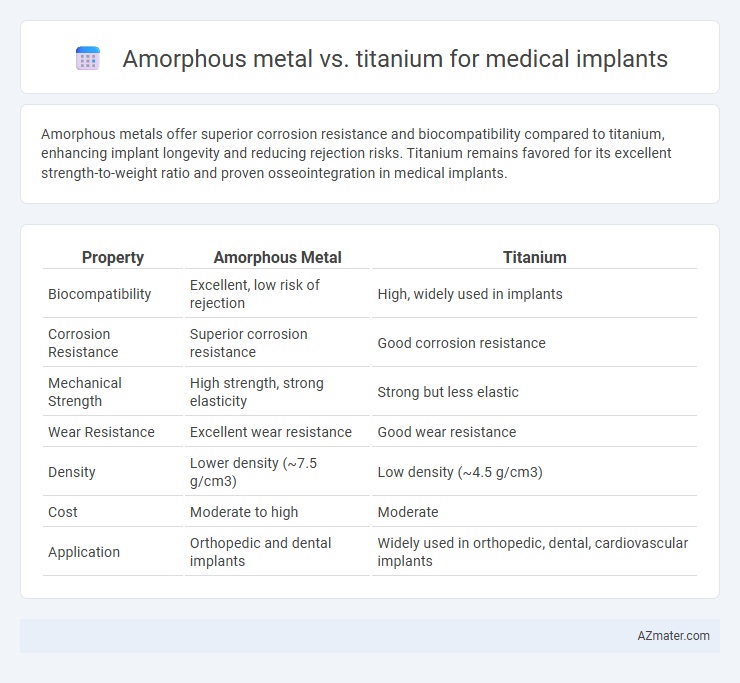Amorphous metals offer superior corrosion resistance and biocompatibility compared to titanium, enhancing implant longevity and reducing rejection risks. Titanium remains favored for its excellent strength-to-weight ratio and proven osseointegration in medical implants.
Table of Comparison
| Property | Amorphous Metal | Titanium |
|---|---|---|
| Biocompatibility | Excellent, low risk of rejection | High, widely used in implants |
| Corrosion Resistance | Superior corrosion resistance | Good corrosion resistance |
| Mechanical Strength | High strength, strong elasticity | Strong but less elastic |
| Wear Resistance | Excellent wear resistance | Good wear resistance |
| Density | Lower density (~7.5 g/cm3) | Low density (~4.5 g/cm3) |
| Cost | Moderate to high | Moderate |
| Application | Orthopedic and dental implants | Widely used in orthopedic, dental, cardiovascular implants |
Introduction to Medical Implant Materials
Amorphous metals and titanium are prominent materials in medical implants due to their unique properties. Amorphous metals exhibit superior strength, elasticity, and corrosion resistance because of their disordered atomic structure, enhancing implant longevity and biocompatibility. Titanium's notable biocompatibility, high strength-to-weight ratio, and excellent corrosion resistance make it a standard choice for orthopedic and dental implants.
Overview of Amorphous Metals
Amorphous metals, also known as metallic glasses, possess a disordered atomic structure that provides exceptional strength, high corrosion resistance, and excellent biocompatibility, making them promising for medical implants. Unlike crystalline titanium, amorphous metals exhibit superior wear resistance and reduced risk of ion release, which enhances implant longevity and patient safety. Their unique physical properties enable the design of minimally invasive implants with improved mechanical performance and reduced risk of infection.
Properties of Titanium in Medical Applications
Titanium exhibits exceptional biocompatibility, corrosion resistance, and high strength-to-weight ratio, making it a preferred material for medical implants such as joint replacements and dental prosthetics. Its ability to osseointegrate with bone tissue enhances implant stability and longevity, reducing the risk of implant rejection or failure. Titanium's non-toxic and hypoallergenic properties further ensure patient safety and promote faster healing in medical applications.
Biocompatibility: Amorphous Metal vs Titanium
Amorphous metals exhibit superior biocompatibility due to their unique non-crystalline atomic structure, which reduces corrosion and ion release compared to crystalline titanium alloys. Titanium is widely favored for medical implants because of its excellent corrosion resistance and ability to form a stable oxide layer that promotes osseointegration. However, amorphous metals demonstrate enhanced bacterial resistance and lower metal ion toxicity, positioning them as promising alternatives for long-term implant stability and patient safety.
Mechanical Strength and Durability Comparison
Amorphous metals exhibit superior mechanical strength with high tensile strength and excellent wear resistance compared to titanium, making them highly resistant to deformation under stress. Titanium provides outstanding biocompatibility and corrosion resistance but has lower hardness and fatigue strength relative to amorphous metals. The durability of amorphous metals in medical implants is enhanced by their unique atomic structure, which reduces crack propagation and wear, outperforming titanium in long-term mechanical reliability.
Corrosion and Wear Resistance
Amorphous metals exhibit superior corrosion resistance compared to titanium due to their homogeneous, non-crystalline atomic structure, which eliminates grain boundaries that are common sites for corrosion initiation. The enhanced wear resistance of amorphous metals stems from their high hardness and elastic limit, outperforming titanium's crystalline alloys under repetitive stress conditions in medical implants. These properties make amorphous metals particularly advantageous for surgical applications requiring prolonged durability and biocompatibility in corrosive bodily environments.
Osseointegration Performance
Amorphous metals exhibit superior osseointegration performance compared to titanium due to their unique disordered atomic structure, which enhances biological compatibility and promotes rapid bone cell attachment. Studies indicate that amorphous metal implants demonstrate increased surface energy and improved corrosion resistance, fostering better bone-implant interface stability. Titanium remains widely used for its strength and biocompatibility, but amorphous metals are gaining attention for faster integration and reduced inflammatory response in medical implant applications.
Imaging Compatibility and Artifact Reduction
Amorphous metals exhibit superior imaging compatibility in medical implants due to their non-crystalline atomic structure, which minimizes magnetic susceptibility artifacts in MRI and reduces CT imaging distortions compared to crystalline titanium alloys. Titanium, while biocompatible and corrosion-resistant, often generates more pronounced artifacts caused by its higher magnetic properties and density variance, impacting diagnostic clarity. The use of amorphous metal implants enhances artifact reduction, enabling clearer visualization of surrounding tissues and improved post-operative assessment accuracy.
Manufacturing and Cost Considerations
Amorphous metals offer superior biocompatibility and corrosion resistance but often require advanced manufacturing techniques like rapid solidification, which can increase production complexity and costs. Titanium, widely used in medical implants, benefits from established manufacturing processes such as machining and additive manufacturing, enabling lower overall production expenses. Cost considerations often favor titanium due to its availability and mature supply chain, despite the enhanced properties of amorphous metals that could improve implant longevity and performance.
Future Prospects in Implant Technology
Amorphous metals offer superior corrosion resistance and higher strength-to-weight ratios compared to titanium, making them promising candidates for next-generation medical implants. Advanced research in nanostructured amorphous alloys aims to enhance biocompatibility and fatigue performance, potentially surpassing titanium's long-term durability. Integration of amorphous metal technology with additive manufacturing techniques could revolutionize custom implant designs and accelerate clinical adoption.

Infographic: Amorphous metal vs Titanium for Medical implant
 azmater.com
azmater.com